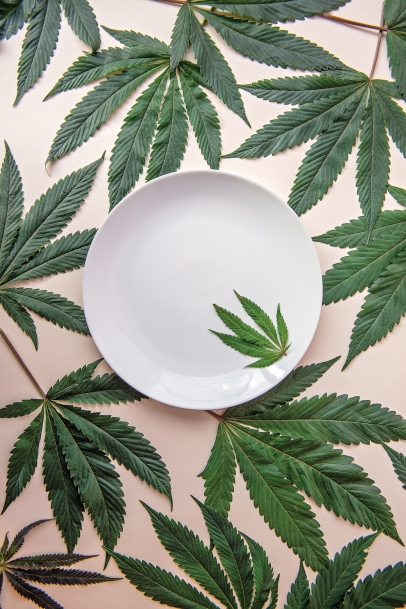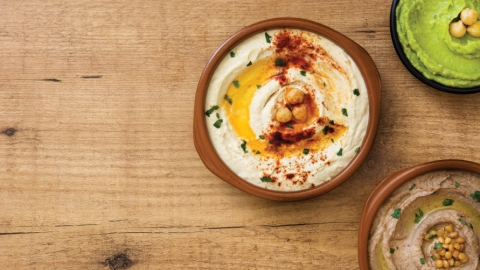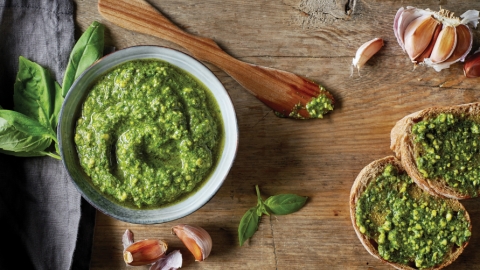An Edible Dinner Party
Creating a gathering around cannabis edibles can be exhilarating—and intimidating. This culinary herb is packed with flavour, but each strain displays unique characteristics in flavour and effects. Infuse into salad dressings, drizzle on hummus, toast on crostini, use in pesto or chimichurri or even whip into a frosting. Anywhere oil is used in a recipe, a portion can be replaced with cannabis oil.
Cannabis Compounds
The two compounds of cannabis you will be dealing with are THC (psychoactive) and CBD (non psychoactive). For more information, talk to your local budtender (and refer to our High Times article).
Dosing accurately is the most challenging component of cooking with cannabis; converting THC and CBD percentages into milligrams infused into oil is more than a little math homework. Experimenting is the best way to find what works for you, so start small and use strains with low THC content. As CBD doesn’t have the same psychoactive effects as THC, starting with a strain containing a THC content of 10–15% is best for beginners. A good guideline is to keep the THC to between one and five milligrams per course, or one teaspoon per person, per serving.
Most importantly, pace yourself. Cooking with cannabis can result in consuming more of the drug than initially intended (especially if it's infused into more than one course), as eating cannabis results in a higher concentration and yields slightly different effects than if it is inhaled. When inhaling cannabis, the effects are almost instant and dissipate in a few hours; when eaten, it typically takes over an hour to feel the full effect, yet the effect can last up to 12 hours. Since the effects are long-lasting, it’s wise to accurately micro-dose throughout the meal.
The possibilities are endless when it comes to being creative with cannabis in the kitchen. Not only do we want to feel the effects of the cannabis, but we want to ensure the food tastes good too. So, it is just as important to consider the terpene profile as it is to determine the CBD and THC content. The terpene profile is the spectrum of flavour the cannabis strain exhibits—your budtender should be able to help you out. Choosing a strain determines the flavour and effect you would like your meal to have. Is this a relaxing evening where everyone needs to unwind after a long week or an energizing brunch to start the weekend?

With this table in mind, you can confidently create a variety of oils based on your favourite strains and incorporate them into your favourite recipes.
Tips for Infusing Your Own Cannabis Oil
- Combine 1 cup of oil to 8-10 g of cannabis (buds, stems and trim all work well for making oil). This ratio has the best lipid-to-THC concentration for extraction.
- Activate the cannabis by spreading it on a parchment-covered baking sheet and roasting at 250°F for 30 minutes, stirring every 10 minutes. Remove from heat and allow to cool completely before proceeding.
- Roughly chop the buds to increase the surface area and allow for consistent absorption. (Chopping too finely or to a powder consistency will impart intense plant and grassy flavours, which can't be removed.)
- Add chopped buds to a few disposable tea bags or cheese cloth, like a bouquet garni. This allows the oil to fully infuse without the need to strain later.
- Use coconut oil as the base oil for infusion. The high concentration of saturated fat in this oil allows more of the cannabinoids to bind, which enables it to be solid at room temperature so it can be used as a butter or a true oil.
- Place in a small pot to simmer with a thermometer attached to the side. Keep the oil at a consistent 180-200°F (to keep from burning off essential cannabinoids) and infuse for three hours. If you infuse for longer, more plant flavours will be infused, instead of your desired terpene profile. Slow cookers are often recommended, but their temperature is harder to control.
- Whip it using an electric mixer once the oil has cooled and solidified to eliminate inconsistencies (as every cannabinoid has a different molecular weight and will come to rest at a different vertical level in the oil).
- Store in a dark glass container in the fridge; it will keep for between 60-90 days.







